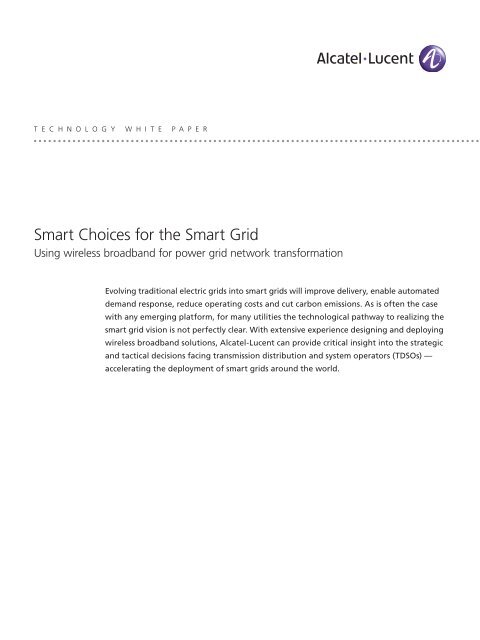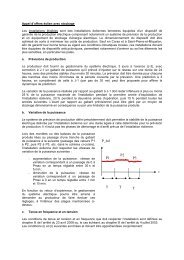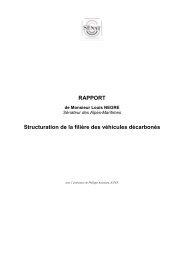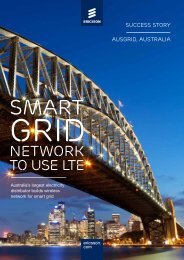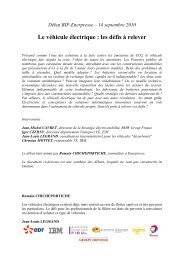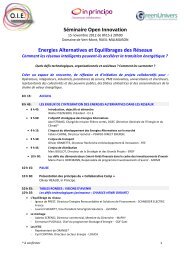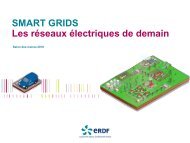Smart Choices for the Smart Grid - Smart Grids
Smart Choices for the Smart Grid - Smart Grids
Smart Choices for the Smart Grid - Smart Grids
Create successful ePaper yourself
Turn your PDF publications into a flip-book with our unique Google optimized e-Paper software.
T E C H N O L O G Y W H I T E P A P E R<br />
<strong>Smart</strong> <strong>Choices</strong> <strong>for</strong> <strong>the</strong> <strong>Smart</strong> <strong>Grid</strong><br />
Using wireless broadband <strong>for</strong> power grid network trans<strong>for</strong>mation<br />
Evolving traditional electric grids into smart grids will improve delivery, enable automated<br />
demand response, reduce operating costs and cut carbon emissions. As is often <strong>the</strong> case<br />
with any emerging plat<strong>for</strong>m, <strong>for</strong> many utilities <strong>the</strong> technological pathway to realizing <strong>the</strong><br />
smart grid vision is not perfectly clear. With extensive experience designing and deploying<br />
wireless broadband solutions, Alcatel-Lucent can provide critical insight into <strong>the</strong> strategic<br />
and tactical decisions facing transmission distribution and system operators (TDSOs) —<br />
accelerating <strong>the</strong> deployment of smart grids around <strong>the</strong> world.
Table of contents<br />
1 Addressing <strong>the</strong> challenges of smart grid implementation<br />
1 Network ownership vs. leasing of commercial services<br />
2 Network requirements <strong>for</strong> smart grid applications<br />
2 An IP-based technology path<br />
3 Overview of utility network architectures<br />
3 Core high-speed network<br />
3 Wide area network<br />
3 Access network<br />
5 Using wireless broadband services in <strong>the</strong> access layer<br />
6 Reliability<br />
6 Availability<br />
6 Security<br />
6 Spectrum requirements<br />
7 Accelerating <strong>the</strong> deployment of smart grid networks<br />
8 About <strong>the</strong> authors<br />
8 Acronyms
Addressing <strong>the</strong> challenges of smart grid implementation<br />
Technological advancements have radically altered <strong>the</strong> world’s telecommunications networks over<br />
<strong>the</strong> past decade. Yet ano<strong>the</strong>r important network in our day-to-day lives — <strong>the</strong> energy distribution<br />
grid — has been slower to evolve. That is about to change, however, with <strong>the</strong> proliferation of smart<br />
grid technology.<br />
The smart grid is generally characterized as <strong>the</strong> merger of communications-intensive IT applications<br />
with <strong>the</strong> electric power systems managed by transmission and distribution system operators (TDSOs) —<br />
outfitting 20th century electric grids with 21st century telecommunications technology. The smart<br />
grid’s purpose? To create near-real-time control mechanisms that improve <strong>the</strong> quality of electricity<br />
delivery, reduce carbon emissions, incorporate distributed energy resources, provide automated<br />
demand response and reduce <strong>the</strong> cost of electricity to consumers.<br />
A mature smart grid will comprise a number of integrated yet distinct applications that require varying<br />
degrees of reliability, latency, availability, throughput, security and economic justification (not<br />
only <strong>for</strong> <strong>the</strong> TDSO itself, but also in <strong>the</strong> eyes of public service commissions and municipal councils).<br />
As such, TDSOs face many difficult choices with regard to smart grid implementation — in particular,<br />
which specific technologies should be used to create <strong>the</strong> reliable, two-way communications paths<br />
required <strong>for</strong> <strong>the</strong> operation of <strong>the</strong> smart grid infrastructure and <strong>for</strong> <strong>the</strong> data, video, voice and security<br />
needs of <strong>the</strong> associated applications.<br />
There are few easy answers. Different technologies are better suited than o<strong>the</strong>rs <strong>for</strong> specific smart<br />
grid applications, network geographies and customer demographics. The significant experience of<br />
Alcatel-Lucent in designing and deploying mission-critical wired and wireless broadband solutions<br />
provides unique insight into <strong>the</strong> challenges and choices faced by TDSOs. This paper explores some<br />
of <strong>the</strong> more critical choices — both strategic (how to meet shareholder, regulatory and economic<br />
objectives) and tactical (how <strong>the</strong> trans<strong>for</strong>mation translates into <strong>the</strong> procurement of specific products<br />
and services) — that TDSOs face in weighing <strong>the</strong> merits of implementing wireless broadband services<br />
and trans<strong>for</strong>ming <strong>the</strong> energy distribution infrastructure into a modern smart grid.<br />
Network ownership vs. leasing of commercial services<br />
TDSOs considering smart grid network improvements must first consider <strong>the</strong> advantages and disadvantages<br />
associated with ei<strong>the</strong>r owning <strong>the</strong>ir own network or leasing a network from a commercial<br />
service provider. To maintain control, most TDSOs prefer exclusive ownership of <strong>the</strong> communications<br />
and IT infrastructure supporting <strong>the</strong>ir operational networks. As well, owning <strong>the</strong> network is often<br />
perceived as simpler: embedding commercial services — whe<strong>the</strong>r wireless or leased line — within<br />
an integrated communications network complicates <strong>the</strong> physical and logical connectivity of <strong>the</strong><br />
architecture as well as functions associated with routing, reliability, security, regulatory compliance<br />
and supply chain management.<br />
Owning a private communications network, however, may not be an option <strong>for</strong> all TDSOs <strong>for</strong> reasons<br />
of cost, lack of in-house network design and maintenance skills, or capacity to deploy applications<br />
expeditiously. Moreover, owning such a network can extend technology refresh cycles. Commercial<br />
service providers have extensive experience managing complex technology infusions according to<br />
strict audit and regulatory standards, which allows <strong>the</strong>m to regularly update and integrate new technologies<br />
<strong>for</strong> consumer use. TDSOs can find this difficult to replicate. And while commercial service<br />
providers can share <strong>the</strong> costs of such upgrades among many customers, network-owning TDSOs<br />
must shoulder <strong>the</strong>m alone.<br />
Ultimately, <strong>the</strong> choice of whe<strong>the</strong>r to use commercially available services or to build and maintain<br />
an independent network will be based on each TDSO’s network requirements and <strong>the</strong> associated<br />
costs and business risks.<br />
<strong>Smart</strong> <strong>Choices</strong> <strong>for</strong> <strong>the</strong> <strong>Smart</strong> <strong>Grid</strong> | Technology White Paper 1
Network requirements <strong>for</strong> smart grid applications<br />
Network requirements associated with smart grid applications play a considerable role in determining<br />
how TDSOs implement <strong>the</strong> technology into <strong>the</strong>ir energy distribution infrastructures. The following<br />
table lists some of <strong>the</strong> most important smart grid applications, as well as o<strong>the</strong>r utility applications<br />
typically carried over <strong>the</strong> communications network, and <strong>the</strong>ir qualitative network requirements.<br />
Table 1. Network requirements <strong>for</strong> smart grid applications<br />
Application<br />
Data rate/volume<br />
(at endpoint)<br />
Latency allowance<br />
(one-way)<br />
Reliability<br />
Security<br />
<strong>Smart</strong> metering Low/Very low High Medium High<br />
Inter-site rapid response<br />
(<strong>for</strong> example, Teleprotection)<br />
High/Low Very low Very high Very high<br />
SCADA Medium/Low Low High High<br />
Operations data Medium/Low Low High High<br />
Distribution automaton Low/Low Low High High<br />
Distributed energy management and<br />
control (DER, storage, PEV)<br />
Medium/Low Low High High<br />
Video surveillance High/Medium Medium High High<br />
Mobile work<strong>for</strong>ce (Push to Talk) Low/Low Low High High<br />
Corporate data Medium/Low Medium Medium Medium<br />
Corporate voice Low/Very low Low High Medium<br />
Latency requirements <strong>for</strong> smart grid and o<strong>the</strong>r utility applications vary: less than 10 ms <strong>for</strong> teleprotection;<br />
about 20 ms <strong>for</strong> some synchrophasor applications; 100 to 200 ms <strong>for</strong> most smart grid supervisory<br />
control and data acquisition (SCADA) and voice-over Internet protocol (VoIP) applications; and<br />
up to several seconds <strong>for</strong> smart metering and o<strong>the</strong>r applications. Unlike most o<strong>the</strong>r enterprise data<br />
networks, support <strong>for</strong> geographically dispersed utility applications with latency requirements of<br />
less than 100 ms represents one of <strong>the</strong> most challenging aspects of wireless network design. O<strong>the</strong>r<br />
than <strong>the</strong>se very low latency applications, many current commercial wireless services can satisfy <strong>the</strong><br />
requirements of smart grid applications when latency requirements are 150 ms or greater.<br />
It is also important to consider instances when application requirements change due to <strong>the</strong> operational<br />
context. For example, active demand response and emergency load management require higher reliability<br />
and lower latency as an integrated system than as part of a stand-alone Automated Metering<br />
Infrastructure (AMI) application.<br />
Alcatel-Lucent believes that application-specific, single-purpose networks (such as <strong>for</strong> SCADA) will<br />
be far too expensive and unmanageable in <strong>the</strong> smart grid scenario, as <strong>the</strong>re will be many different<br />
applications penetrating <strong>the</strong> distribution grid. A better, less costly strategy would be an integrated<br />
communications network supporting all applications, with proper implementation of quality of service<br />
(QoS), reliability, security and unified network management tools to ensure delivery of critical smart<br />
grid application traffic.<br />
An IP-based technology path<br />
Although no single communications technology is best <strong>for</strong> all smart grid applications, Alcatel-Lucent<br />
believes <strong>the</strong> end-to-end network layer technology of choice will be IP. The IP suite of technologies<br />
offers <strong>the</strong> needed levels of reliability, redundancy and availability, and can leverage an extensive<br />
ecosystem of products and services designed <strong>for</strong> telecommunications. 1 Moreover, IP has been subjected<br />
to decades of significant vetting as a network routing protocol, resulting in a robust technology with<br />
a mature set of management and security applications to employ.<br />
1<br />
It must be noted that IP networks do not necessarily imply use of <strong>the</strong> Internet.<br />
2<br />
<strong>Smart</strong> <strong>Choices</strong> <strong>for</strong> <strong>the</strong> <strong>Smart</strong> <strong>Grid</strong> | Technology White Paper
IP-based networks must also continue to support legacy systems and applications by providing <strong>the</strong><br />
necessary gateways and protocol conversions even as new, IP-based applications are deployed by TDSOs.<br />
(IP will be <strong>the</strong> technology of choice <strong>for</strong> most applications.) Legacy protocols can be carried through<br />
IP using a variety of methods such as tunneling via multiprotocol label switching (MPLS) — a proven<br />
technology deployed broadly in large enterprise and carrier networks and already being adopted by<br />
<strong>the</strong> utility industry.<br />
Overview of utility network architectures<br />
A typical utility network consists of <strong>the</strong> following:<br />
• A core high-speed network, which is usually comprised of high-bandwidth optical and microwave links<br />
• A wide area network (WAN), which aggregates traffic from <strong>the</strong> many different kinds of data,<br />
voice and video applications running in <strong>the</strong> access layer<br />
• An access network, which generally includes AMI mesh/PLC and neighborhood area networks<br />
(NAN) supporting distribution substations, mobility and feeder applications<br />
Core high-speed network<br />
A TDSO’s data and control centers, utility offices, bulk generation sites, metro-area substations and<br />
market entities such as independent system operators may all be served directly by <strong>the</strong> core high-speed<br />
network. Overall, <strong>the</strong> core network should be designed <strong>for</strong> automatic fail-over and traffic rerouting,<br />
preferably at less than 50 ms, to ensure continuity of latency sensitive applications.<br />
The core network is increasingly multi-service IP/MPLS running over carrier-grade optical and<br />
microwave transmission equipment that provides SONET and/or E<strong>the</strong>rnet transport. Fiber (as ei<strong>the</strong>r<br />
privately owned or a mix of private fiber and commercial E<strong>the</strong>rnet services) is <strong>the</strong> preferred medium,<br />
as even higher aggregate bandwidth rates can be achieved by upgrading existing fiber with wave<br />
division multiplexing technologies. However, microwave can also be used in <strong>the</strong> core network if<br />
<strong>the</strong> economics of laying fiber are not feasible.<br />
Wide area network<br />
The multi-service capabilities of IP/MPLS may be extended into <strong>the</strong> TDSO’s wide area network to<br />
facilitate <strong>the</strong> aggregation and management of <strong>the</strong> many different network protocols. For example,<br />
implementing MPLS <strong>for</strong> TDM, DNP3, 4-wire and o<strong>the</strong>r applications provides <strong>the</strong> advantages of<br />
streamlined QoS, security implementation, and traffic separation and prioritization due to MPLS<br />
virtual private networks (such as virtual LANs).<br />
Locations such as transmission and distribution substations, or devices like AMI traffic concentrators<br />
that are collectively part of <strong>the</strong> distribution grid, require reliable communications paths back to <strong>the</strong><br />
high-speed core network. TDSOs have many technology choices <strong>for</strong> WAN communications o<strong>the</strong>r<br />
than MPLS, including leased lines, point-to-point and/or point-to-multi-point private microwave,<br />
and VPNs running over <strong>the</strong> Internet. In addition, critical voice services may ride over private, licensed<br />
land-mobile radio systems, as may a portion of mobile data traffic. However, TDSOs will try to minimize<br />
<strong>the</strong> number of communications technologies used in <strong>the</strong> WAN in order to simplify <strong>the</strong> configuration<br />
and operation of <strong>the</strong>se networks, as <strong>the</strong>re may be hundreds, if not thousands, of virtual and real<br />
physical connections to manage.<br />
Access network<br />
The access portion of <strong>the</strong> smart grid network will require <strong>the</strong> highest level of customization so that<br />
TDSOs can cost-effectively meet <strong>the</strong>ir unique requirements (<strong>for</strong> example, differences in geography<br />
and demographics). At <strong>the</strong> access level, both wireless and wireline broadband technologies can<br />
be configured to meet most application requirements. (Examples of wireless technologies include<br />
WiMAX, LTE, CDMA 2000 EvDO and HSPA. Wireline examples include DSL, DOCSIS, GPON<br />
and PLC, including BPL.) In <strong>the</strong> end, <strong>the</strong> choice of access technology will mostly depend on <strong>the</strong><br />
cost-effectiveness and ability of <strong>the</strong> technology to provide suitable coverage.<br />
<strong>Smart</strong> <strong>Choices</strong> <strong>for</strong> <strong>the</strong> <strong>Smart</strong> <strong>Grid</strong> | Technology White Paper 3
Figure 1. The intersection of communications networks and electricity grids<br />
EMS/<br />
SCADA DMS/DA MDMS DR OMS IDS NMS<br />
Transmission<br />
and distribution<br />
operation center<br />
Firewall<br />
Firewall<br />
Communications<br />
network<br />
operations center<br />
MPLS<br />
E<strong>the</strong>rnet MW<br />
Multiservice<br />
core<br />
WAN<br />
IED<br />
Commercial customer<br />
WiMAX<br />
Industrial customer<br />
Power plant<br />
Transmission<br />
substation<br />
Distribution<br />
substation<br />
WiFi/<br />
WiMAX<br />
Distributed<br />
generation<br />
NAN concentrator<br />
WiFi/WiMAX/LTE/CDMA<br />
WiFi/<br />
WiMAX/<br />
LMR<br />
VoIP<br />
IED<br />
CCTV<br />
Substation<br />
components<br />
RTU<br />
DAS<br />
FTTH<br />
PLC<br />
HAN<br />
Residential<br />
customer<br />
EV charging<br />
Display<br />
Mobile<br />
work<strong>for</strong>ce<br />
NAN<br />
Meter<br />
Mesh<br />
<strong>Smart</strong><br />
meter<br />
900 MHz<br />
or WiMAX<br />
PT2MP<br />
HVAC/<br />
<strong>the</strong>rmostat<br />
Water heater<br />
Wind/solar<br />
micro-generation<br />
4<br />
<strong>Smart</strong> <strong>Choices</strong> <strong>for</strong> <strong>the</strong> <strong>Smart</strong> <strong>Grid</strong> | Technology White Paper
<strong>Smart</strong> metering solutions<br />
One of <strong>the</strong> key elements of <strong>the</strong> smart grid is its capacity to support advanced metering solutions.<br />
Where a TDSO is publicly owned and can offer its own revenue-generating services (such as Internet<br />
access and IPTV services), fiber can be provided directly to customers at <strong>the</strong> access level, using<br />
technologies such as GPON that enable <strong>the</strong> installation of E<strong>the</strong>rnet-capable smart meters. TDSOs<br />
that are limited or prohibited from offering additional services may choose to use a customer’s existing<br />
broadband connection. However, TDSOs wishing to deploy a smart metering solution that relies<br />
on third-party broadband access face a number of challenges, including <strong>the</strong> fact that it is far from<br />
certain that every customer will subscribe to, or stay subscribed to, that particular third-party broadband<br />
service. As a result, it may be better to invest in wireless access networks (whe<strong>the</strong>r narrowband<br />
like 900 MHz or broadband like WiMAX) to guarantee access to smart meters.<br />
O<strong>the</strong>r options <strong>for</strong> carrying low bit rate, high-density smart metering traffic include PLC (wireline) or<br />
RF mesh over an unlicensed spectrum at 900 MHz ISM 2 and 2.4 GHz (WiFi). Technologies such as<br />
900 MHz ISM, however, are cost-effective only in high-density urban and suburban environments<br />
where signal coverage can take advantage of shorter hops between meters and/or numerous towers.<br />
As real-time demand response becomes a reality, <strong>the</strong>se low bit rate, unlicensed network systems will<br />
require migration to o<strong>the</strong>r technologies that support broadband communications (such as WiMAX<br />
and LTE). Also, as latency-sensitive, real-time telemetry control applications are deployed across <strong>the</strong><br />
distribution grid (such as syncrophasor control and o<strong>the</strong>r real-time sensors), spectrum interference in<br />
unlicensed bands or across commercial carrier networks will inhibit <strong>the</strong> deployment and usefulness of<br />
unlicensed radio systems.<br />
In addition to smart meters, buildings on <strong>the</strong> electric grid may also feature local electricity generation<br />
facilities (such as photovoltaic cells or uninterruptible power supplies) and storage facilities (<strong>for</strong> plug-in<br />
hybrid electric vehicles, <strong>for</strong> example). These facilities may be connected, along with <strong>the</strong> meter, over<br />
a local area network (LAN) or a home area network (HAN) to manage <strong>the</strong> building’s energy usage<br />
through protocols such as Zigbee and HomePlug. As buildings also gain smarter management capabilities,<br />
bandwidth needs will increase — putting pressure on 900 MHz RF and PLC technologies<br />
and accelerating <strong>the</strong> need <strong>for</strong> broadband connections directly into <strong>the</strong>se high-traffic sites.<br />
Using wireless broadband services in <strong>the</strong> access layer<br />
Many smart grid applications being deployed today can adequately operate on existing commercial<br />
wireless networks. However, out of concerns that <strong>the</strong> quality and reliability of commercial services<br />
create unjustifiable operational risk, most utilities prefer exclusive access arrangements. As an example,<br />
priority network access and priority flow management are key requirements <strong>for</strong> critical smart grid<br />
applications. To encourage widespread adoption of commercial services by TDSOs, commercial<br />
wireless providers will need to adopt <strong>the</strong> technologies necessary to permit critical utility traffic to<br />
preempt non-critical commercial traffic.<br />
United States industry regulations dictate that acceptable communication network per<strong>for</strong>mance,<br />
security and reliability requirements must be met during wide-scale power outages and <strong>the</strong> resulting<br />
‘black start’ processes <strong>for</strong> grid restoration. In <strong>the</strong> event of an extended power outage (often 72 hours<br />
or more), wireless networks will need to function independently of commercial electric service to<br />
sustain critical voice and data communications. This capability is not prevalent today in commercial<br />
wireless networks and would require significant investment in emergency power infrastructure<br />
to remediate.<br />
That being said, how should TDSOs expect wireless broadband services in <strong>the</strong> access layer to be used<br />
in order to meet <strong>the</strong> requirements and challenges associated with network reliability, availability<br />
and security?<br />
2<br />
Mesh connections between meters and <strong>the</strong>ir concentrator over unlicensed 900 MHz ISM (industrial, scientific and medicine) band<br />
in a neighborhood<br />
<strong>Smart</strong> <strong>Choices</strong> <strong>for</strong> <strong>the</strong> <strong>Smart</strong> <strong>Grid</strong> | Technology White Paper 5
Reliability<br />
Today, applications such as meter reading can reliably run over commercial wireless networks due to<br />
<strong>the</strong>ir relatively flexible requirements — dropped ‘calls,’ or even loss of <strong>the</strong> commercial network <strong>for</strong> a<br />
period of time, are not fatal to <strong>the</strong>se devices or applications. Once traffic from many such devices is<br />
aggregated and presented to <strong>the</strong> network (along with demand response, substation monitoring and<br />
control, and o<strong>the</strong>r core smart grid applications), <strong>the</strong> availability requirements laid on commercial<br />
wireless networks are significantly increased.<br />
While some commercial carriers are beginning to offer service level agreements (SLAs) to utilities<br />
and o<strong>the</strong>r customers, commercial wireless networks today were built and continue to operate using<br />
a best-ef<strong>for</strong>t, one-size-fits-all standard <strong>for</strong> consumer applications. Satisfying <strong>the</strong> needs of TDSOs<br />
will pressure commercial wireless carriers to offer SLAs — different from those provided to <strong>the</strong>ir<br />
consumer customers — that guarantee an appropriate level of network per<strong>for</strong>mance even under<br />
adverse conditions, especially environmental factors (<strong>for</strong> example, local congestion due to wea<strong>the</strong>r<br />
or newsworthy events) or security incidents (such as government mandates limiting commercial<br />
traffic in <strong>the</strong> event of a terrorist attack).<br />
Availability<br />
Electric utilities offer nearly universal service, especially in many geographies where no suitable<br />
communications networks currently exist. As such, TDSOs may be <strong>for</strong>ced to consider <strong>the</strong> use<br />
of alternative low-bandwidth (but sometimes high-cost) technologies, including PLC, satellite<br />
communications and unlicensed RF mesh, to provide <strong>the</strong>mselves with service. However, as new<br />
smart grid applications are deployed and radio-enabled grid components become more prevalent,<br />
wireless broadband and wireline technologies will be able to provide <strong>the</strong> most suitable access options.<br />
In addition, it is unlikely that <strong>the</strong> needs of TDSOs alone will justify <strong>the</strong> significant investment<br />
required of commercial service providers to provide ubiquitous broadband coverage <strong>for</strong> <strong>the</strong> utility<br />
industry. Instead, co-investment partnerships may present <strong>the</strong> best way <strong>for</strong> both commercial<br />
providers and TDSOs to meet <strong>the</strong>ir goals and requirements.<br />
Security<br />
While commercial wireless services are able to meet <strong>the</strong> security requirements <strong>for</strong> smart grid applications,<br />
it is unclear whe<strong>the</strong>r NERC CIP accountability standards will evolve to a level that will require <strong>the</strong><br />
TDSO to be accountable <strong>for</strong> end-to-end security of data, regardless of <strong>the</strong> network owner. The primary<br />
issue today regarding use of commercial carrier networks is ultimately one of availability, not security.<br />
Spectrum requirements<br />
Most TDSOs have access to some licensed spectrum, primarily in narrow-band frequencies intended<br />
<strong>for</strong> land-mobile radio. However, <strong>the</strong>se licensed frequency assignments are not adequate <strong>for</strong> mobile<br />
work<strong>for</strong>ce support, video surveillance or o<strong>the</strong>r future real-time grid control applications. In fact,<br />
<strong>the</strong>re are very few, if any, TDSOs in <strong>the</strong> United States that currently have sufficient spectrum to<br />
support multiple smart grid applications. A recent study conducted by Alcatel-Lucent <strong>for</strong> a large<br />
TDSO with 20 x 12.5 kHz channels of licensed 900 MHz concluded that 3 Mb/s of constant bit rate<br />
wireless throughput per sector (5 Mb/s <strong>for</strong> peak throughput) will be required <strong>for</strong> smart grid, mobile<br />
work<strong>for</strong>ce and substation security applications — and recent work done by <strong>the</strong> Utilities Telecom<br />
Council 3 quantified <strong>the</strong> need <strong>for</strong> up to 8 Mb/s per sector to support peak traffic demand. In <strong>the</strong> case<br />
of <strong>the</strong> TDSO profiled in <strong>the</strong> Alcatel-Lucent study, 20 channels of narrowband licensed LMR spectrum<br />
will clearly not be sufficient <strong>for</strong> this level of application data throughput.<br />
3<br />
“<strong>Smart</strong> <strong>Grid</strong> Spectrum Requirements.” Klaus Bender, UTC Journal 3Q 2009, p. 21-23.<br />
6<br />
<strong>Smart</strong> <strong>Choices</strong> <strong>for</strong> <strong>the</strong> <strong>Smart</strong> <strong>Grid</strong> | Technology White Paper
<strong>Smart</strong> metering applications<br />
In addition to <strong>the</strong> grid control applications described above, some TDSOs are using 220 MHz and<br />
900 MHz licensed spectrum <strong>for</strong> smart metering applications. O<strong>the</strong>r manufacturers are building smart<br />
meters with 3G radios so that <strong>the</strong> meter can communicate directly with <strong>the</strong> commercial wireless<br />
provider’s network. Although smart metering is <strong>the</strong> primary application, this solution can also carry<br />
smart grid traffic from o<strong>the</strong>r distribution grid elements, such as feeder-mounted voltage sensors.<br />
Currently, unlicensed spectrum is <strong>the</strong> dominant solution <strong>for</strong> private network communications of<br />
wireless meter applications in <strong>the</strong> United States. Many current smart metering solutions use 900 MHz<br />
unlicensed spectrum with channels in <strong>the</strong> 902 to 928 MHz band with several hundred kilohertz<br />
per channel. Zigbee (2.4 GHz) is generally used in home area networks in <strong>the</strong> United States but<br />
has been used <strong>for</strong> smart metering in o<strong>the</strong>r countries. WiFi mesh is ano<strong>the</strong>r possibility, along with<br />
WiMAX in <strong>the</strong> lightly licensed 3.65 GHz band.<br />
Overcoming frequency interference<br />
While most vendors of unlicensed spectrum equipment today provide mechanisms to circumvent<br />
frequency interference (such as channel hopping or increasing power), and as more businesses use<br />
<strong>the</strong>se frequencies <strong>for</strong> smart meters and o<strong>the</strong>r smart grid applications, <strong>the</strong> problem of interference<br />
becomes compounded. This will result in a growing problem with latency — posing a significant<br />
threat to grid stability and reliability.<br />
Interference problems in unlicensed bands can be offset by thorough RF studies and planning.<br />
However, as <strong>the</strong> unlicensed RF environment is subject to change as o<strong>the</strong>r entities add or remove<br />
equipment operating in <strong>the</strong> same band, network per<strong>for</strong>mance can be affected — regardless of <strong>the</strong><br />
level of planning and optimization — ultimately requiring <strong>the</strong> TDSO to constantly monitor<br />
RF per<strong>for</strong>mance and retune systems as conditions change.<br />
The traffic profile challenge<br />
For many smart grid applications, <strong>the</strong> downlink traffic is less than <strong>the</strong> uplink traffic — <strong>the</strong> exact<br />
opposite of <strong>the</strong> typical traffic profile in <strong>the</strong> consumer world. In this sense, commercial networks<br />
using time division duplexing (TDD) are not ideal from a TDSO’s perspective. For <strong>the</strong> TDSO, TDD<br />
ratios should be even or biased upstream to reflect <strong>the</strong> true nature of smart grid application traffic.<br />
Accelerating <strong>the</strong> deployment of smart grid networks<br />
It is evident that TDSOs face a number of critical choices with regard to smart grid deployment.<br />
Overall, Alcatel-Lucent believes that access to contiguous spectrum allocation providing at least 3 to<br />
5 Mb/s (or greater) of wireless throughput per sector would rapidly speed up <strong>the</strong> adoption of smart grid<br />
networks, while overcoming many of <strong>the</strong> challenges inherent in unlicensed bands and commercial<br />
wireless services. This spectrum could be made available through public/private partnerships or by<br />
<strong>the</strong> FCC as a dedicated utility spectrum allocation.<br />
In addition, Alcatel-Lucent recommends that lower spectrum bands should be used <strong>for</strong> smart grid<br />
technology, as <strong>the</strong>y satisfy <strong>the</strong> requirements of TDSOs operating in both dense urban environments<br />
(which require building penetration) as well as rural environments (which need cost-effective cov erage).<br />
The benefits of this approach are many, principally in <strong>the</strong> assurance of access to sufficient bandwidth<br />
— without <strong>the</strong> risk of per<strong>for</strong>mance degradation that would be unacceptable in <strong>the</strong> mission critical<br />
nature of smart grid communications.<br />
<strong>Smart</strong> <strong>Choices</strong> <strong>for</strong> <strong>the</strong> <strong>Smart</strong> <strong>Grid</strong> | Technology White Paper 7
About <strong>the</strong> authors<br />
Acronyms<br />
Dr. Jayant Deshpande<br />
Jayant Deshpande is a member of <strong>the</strong> technical team at Alcatel-Lucent Bell Labs, where he has worked<br />
<strong>for</strong> most of <strong>the</strong> past 26 years. His current focus is smart grid architecture, design and per<strong>for</strong>mance; he<br />
previously worked on data and voice networking services development, QoS, and network architecture,<br />
design, planning and per<strong>for</strong>mance analysis. Jayant has also worked at AT&T Labs and held a brief<br />
tenure at Cisco Systems. Be<strong>for</strong>e joining Bell Labs in 1983, Jayant was a member of <strong>the</strong> Computer<br />
Science and Electrical Engineering faculty at <strong>the</strong> Indian Institute of Technology in New Delhi,<br />
and was a visiting faculty member at Pennsylvania State University.<br />
Arthur Locke<br />
Arthur Locke is Regional Vice President <strong>for</strong> North American Utility Markets in Alcatel-Lucent<br />
Vertical Market Services Division. In his role, he develops services-led turnkey solutions <strong>for</strong> electric<br />
utilities. Arthur has 25 years of experience in <strong>the</strong> communications sector, <strong>the</strong> past 10 of which have been<br />
spent developing and delivering managed network services <strong>for</strong> communications-intensive enterprises.<br />
Mark Madden<br />
Mark Madden is Regional Vice President <strong>for</strong> North American Energy Markets in Alcatel-Lucent<br />
Enterprise and Vertical Markets, Solutions and Marketing Division. He sets <strong>the</strong> company’s North<br />
American market strategy <strong>for</strong> <strong>the</strong> utility, oil and gas sectors, and maintains strategic partnerships<br />
with companies in those fields. Mark joined Alcatel-Lucent in 1996 and has worked with leading<br />
IT and telecommunications companies <strong>for</strong> more than 25 years. He has actively consulted electric<br />
utility customers on mission-critical telecommunications technologies <strong>for</strong> <strong>the</strong> past four years.<br />
AMI<br />
Automated Metering Infrastructure<br />
BPL<br />
Broadband over Power Line<br />
CDMA 2000 EvDO Code Division Multiple Access 2000 Evolution Data Optimized<br />
DNP3 Distributed Network Protocol 3<br />
DOCSIS<br />
Data Over Cable Service Interface Specifications<br />
DSL<br />
Digital Subscriber Line<br />
GPON<br />
Gigabit Passive Optical Network<br />
HSPA<br />
High-Speed Packet Access<br />
IPTV<br />
Internet Protocol TV<br />
LTE<br />
Long-Term Evolution<br />
MPLS<br />
Multiprotocol Label Switching<br />
PLC<br />
Power Line Carrier<br />
QoS<br />
Quality of Service<br />
SCADA<br />
Supervisory control and data acquisition<br />
TDSO<br />
Transmission Distribution and System Operator<br />
WAN<br />
wide area network<br />
WiMAX<br />
Worldwide Interoperability <strong>for</strong> Microwave Access<br />
8<br />
<strong>Smart</strong> <strong>Choices</strong> <strong>for</strong> <strong>the</strong> <strong>Smart</strong> <strong>Grid</strong> | Technology White Paper
www.alcatel-lucent.com Alcatel, Lucent, Alcatel-Lucent and <strong>the</strong> Alcatel-Lucent logo<br />
are trademarks of Alcatel-Lucent. All o<strong>the</strong>r trademarks are <strong>the</strong> property of <strong>the</strong>ir respective owners.<br />
The in<strong>for</strong>mation presented is subject to change without notice. Alcatel-Lucent assumes no responsibility<br />
<strong>for</strong> inaccuracies contained herein. Copyright © 2010 Alcatel-Lucent. All rights reserved.<br />
EPG3310091113 (02)


